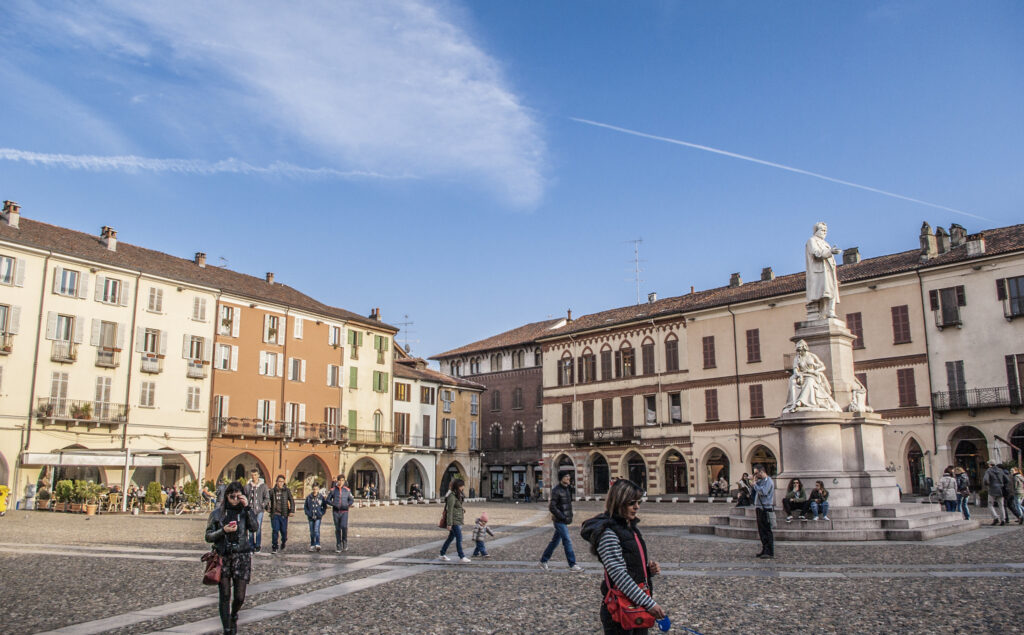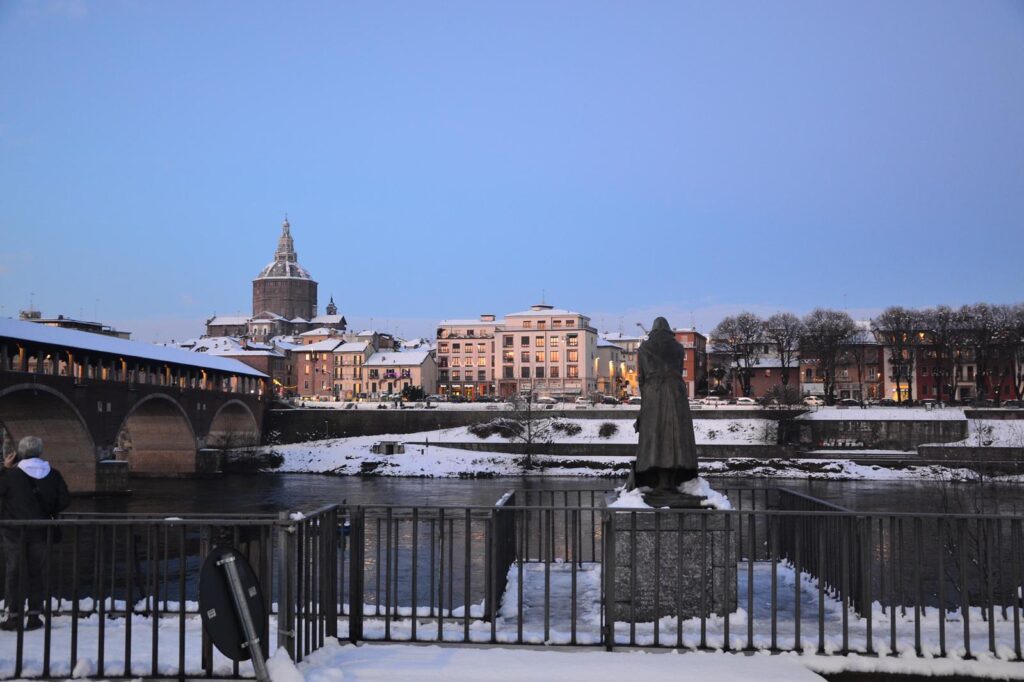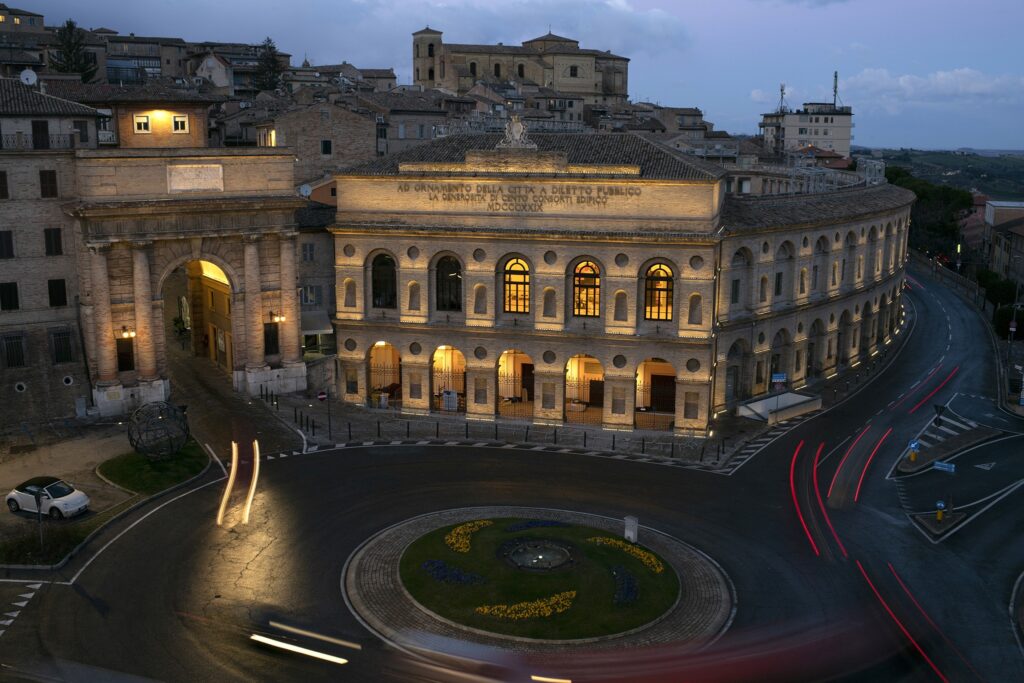From famed Tuscan destinations to remote hilltop hubs, we take a look at Italy’s most charming towns and small cities, where student life meets picturesque urban landscapes.

Students on a break sitting on the duomo stairs in Urbino (Photo: Alain Rouiller via Flickr / CC BY-SA 2.0)
There is a direct correlation between ancient universities and historic towns in Italy. As the Late Middle Ages and Renaissance marked the golden age for many reigns, and duchies and city-states patchworked across the pre-unified country, a host of educational hubs proliferated. They promoted the scientific and humanistic advances of the time while reflecting local wealth, often in fierce competition with each other. Those that still exist today still define the towns they belong to, telling stories of architectural marvels, internationally-reputed scholars and prestigious legacies.
Our article focuses on towns and small cities with less than 100,000 population. We’ve selected them by taking into account the reputation of their universities, with particular regard to historical prestige and international outlook. Le Marche claimed the title of the most represented region in our list, which is ordered from north to south and features a mix of popular and lesser-known destinations. Each presents its own combination of student lifestyle, cultural vibrancy and rich artistic heritage.
Udine
Udine makes for a surprising find in northeastern Italy. Its small and well-kept historic centre is nothing short of a jewel, adorned with porticoes, loggias and other testimonies to the town’s Venetian past. The rural location of the surrounding Friuli region permeates the streets and piazzas, mainly in the form of hearty culinary delights and a staunch local culture. The university has enjoyed an increasingly good reputation in recent times, and a noted international outlook makes it all the more appealing.

Peeking onto Piazza della Libertà, Udine (Photo: Stefano Merli via Flickr / CC BY-SA 2.0)
Vercelli
A riverside town in East Piedmont, Vercelli has become known as the rice capital of Europe. Back in its 13th-century heyday, however, it was cultural and artistic prominence that defined the city. Its first university was founded in 1228 but disappeared within a century, though many Medieval landmarks have survived. Ancient towers and churches blend harmoniously with piazzas and boulevards dating to Napoleonic times, making this one of the most underrated hubs on the Via Francigena pilgrim route. It was perhaps via this route that the famed Vercelli Book, one of the oldest-known manuscripts in archaic English, travelled here. Founded in 1998, the university is split between Vercelli and the nearby towns of Novara and Alessandria.

Piazza Cavour, Vercelli (Photo: Stefano Merli via Flickr / CC BY-SA 2.0)
Pavia
The University of Pavia consistently ranks as one of the most reputable in Italy and is particularly praised for its international outlook. It was officially founded in 1361, but its history dates back to the 9th century. Back then, this riverside town was a well-established capital, which only later yielded in importance to neighbouring Milan. What remains today is a charming historic centre of red bricks and cobbled roads. Some of its landmarks form part of the university complex, including the Botanical Garden and the famed History Museum. Frederick Barbarossa was crowned Emperor at the San Michele Basilica in 1155, while the magnificent Certosa di Pavia sits 10km north of the centre.

The snow-covered riverside of Pavia (Photo: Università di Pavia via Flickr / CC BY 2.0)
Pisa
While tourists visiting Pisa flock to the Leaning Tower, scores of students populate the narrow streets meandering off the Arno river. This former maritime republic has been home to a university since 1343, and the more recent Scuola Normale is today synonymous with elite education. A collection of Romanesque and Gothic gems highlight the town’s Medieval glory, while later Renaissance landmarks also grace the city centre. It all amounts to a bright and tranquil riverside town, whose less obvious attractions are often overlooked by visitors.

Piazza dei Cavalieri watched over by the Clock Palace and the Scuola Normale Superiore (Photo: Ed Webster via Flickr / CC BY 2.0)
Urbino
The birthplace of Raphael, Urbino is a Renaissance town whose extraordinary architecture speaks eloquently of the cultural stature it held between the 15th and 16th centuries. The oldest university dates back to 1506. Its scattered campus includes some of the town’s finest buildings, such as the Convent of Saint Augustin and Bonaventura Palace. The more recent institutes of higher education – Fine Arts and Industrial Design – are also housed at prime historic locations. A university town at heart, Urbino is home to more students than its nearly 14,000 residents. They quickly become familiar with the distinctive piole and volte, brick alleys and vaulted passageways cutting through a harmonious blend of Medieval and Renaissance architecture.

Porticoes leading up to Piazza della Repubblica, Urbino (Photo: Alain Rouiller via Flickr / CC BY-SA 2.0)
Ancona
One of the main ports of the Adriatic Sea, Ancona is the regional capital of Le Marche. It was founded by Greek settlers in 387 BCE, then the Romans made it their maritime gateway to the East. The historic boroughs lie on a promontory topped by the ancient Duomo, originally a 4th-century temple dominating the gulf. Hilltop viewpoints, boulevards and urban parks set the tone of this often-overlooked town, as well as historic landmarks such as the Arch of Trajan and the 16th-century Citadel. A marked international outlook contributes to the university’s good reputation.

The port of Ancona (Photo: Enrico Matteucci via Flickr / CC BY 2.0)
Siena
Quiet and liveable, Siena is one of the most celebrated art towns in Italy. Its exceptionally-preserved Medieval centre rolls time back to the age of comuni, when the town thrived as a cultural and economic hub. The Duomo is a majestic, out-of-scale symbol of the rivalry at the time with nearby Florence, whose ambitious extension plans were only halted by the economic crisis of the 14th century. A famed tourist attraction, Piazza del Campo is also a favourite hangout for many students, lending a vibrant note to the local lifestyle. The main university dates to 1240, while the University for Foreigners offers state-of-the-art education on Italian language and culture.

Tourists and locals alike populate Siena’s Piazza del Campo (Photo: Hervé Simon via Flickr / CC BY-SA 2.0)
Macerata
Another hilltop town home to an ancient university (1290), Macerata combines a provincial mindset with notable cultural liveliness. The scores of students populating it certainly contribute to the latter, and so does a variety of outstanding museums and theatres. The Neoclassic-style Sferisterio is among the best Italian venues to see opera en plein air, while historic palaces such as Palazzo Buonaccorsi and Palazzo Ricci display remarkable art collections. The Clock Tower dates back to the town’s Renaissance heyday. Alongside the main attractions, a network of cobbled lanes and stairways spreads out within 16th-century city walls, unveiling an array of picturesque sights to visitors willing to explore.

The Sferisterio by night (Photo: courtesy of Ufficio Tursimo Comune di Macerata)
Camerino
A small hilltop town counting just above 6,000 residents, Camerino still bears visible scars from the violent earthquake that shook the Marche region in 2016. When approaching from afar, depending on the viewpoint, it might appear as a perched castle or a sloped settlement, pitched on cliff-side walls dating back to 1384. Its artistic and architectural heritage signals the prosperity it enjoyed between 1200 and 1500. Medieval churches, monasteries, fortresses and two ancient gates are some of the town’s landmarks. The prestigious 14th-century university has its headquarters at Palazzo Ducale, which is being restored along with a large section of the historic centre.
Viterbo
Known as the ‘city of popes’, Viterbo preserves a distinctive historic centre encircled by nearly-intact Medieval walls. Its epithet derives from its time as a papal seat in the late 13th century, which left in a grand palace dramatically perched atop a cliff in its wake. The duomo mixes Romanic and Renaissance styles, while San Silvestro Church is where English nobleman Henry of Almain was murdered in 1271 (a case much discussed across Europe at the time). The stone buildings of the old town display peculiar, yet charming, features, such as outdoor stairways running along the facades. A 13th-century complex houses the headquarters of the university.
L’Aquila
Abruzzo is a rather undiscovered destination in central Italy, and so is its main town L’Aquila. The devastating 2009 earthquake was just the latest of a long series recorded in the town’s chronicles, and frequent rebuilding has resulted in a distinctive juxtaposition of Medieval, Renaissance and Baroque heritage. The exquisite Collemaggio Basilica brings together Gothic and Romanic elements, while San Bernardino is an example of post-earthquake restoration. Other landmarks include the ‘99-spout fountain’, the Spanish Fortress and the many gates punctuating the ancient walls. The peaks of wealth and prestige reached by the town are further testified to by its university status, which dates back to the 15th century.
Lecce
The architectural style of Lecce is so recognisable that it named a whole movement – Barocco Leccese. This distinctive character developed in the late 16th century, adorning the city with dazzlingly-decorated churches, facades, gates and balconies. The opulence of details might come across to some as slightly overwhelming but it creates a unique urban environment populated by symbolic decorations and creatures of all sorts. The university adds vibrancy to this pearl of Salento, southern Puglia, which sits equidistant from the Ionian and the Adriatic Seas.

Piazza del Duomo, Lecce (Giuseppe Milo via Flickr / CC BY 2.0)